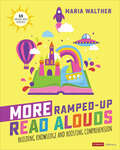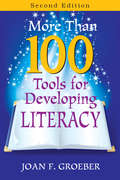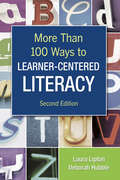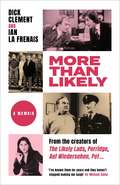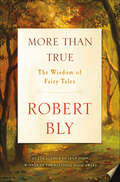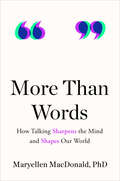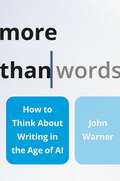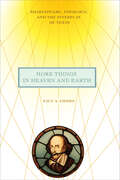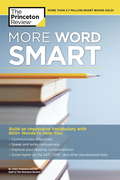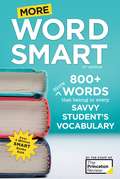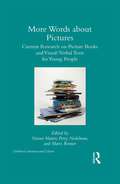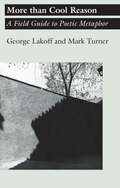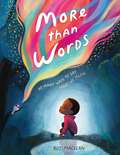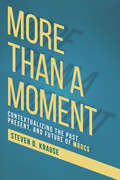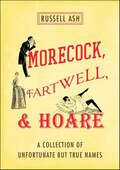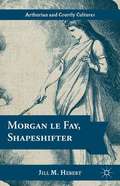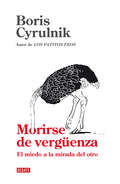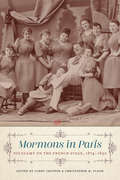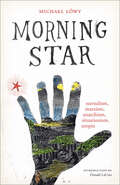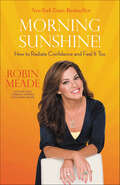- Table View
- List View
More Ramped-Up Read Alouds: Building Knowledge and Boosting Comprehension (Corwin Literacy)
by Maria P. WaltherUnlock the transformative potential of read-aloud to joyfully strengthen essential literacy skills. In this eagerly anticipated follow-up to Maria Walther’s The Ramped-Up Read Aloud, discover 50 MORE read-aloud experiences designed to bolster students’ literacy development, ignite imagination, and enhance motivation. Backed by the latest research, this indispensable guide equips educators with the knowledge and tools to make read alouds a cornerstone of their teaching practice. More Ramped-Up Read Alouds includes lessons focused on foundational reading concepts like phonological awareness and decoding along with a new chapter on integrating literacy with STEAM. This must-have resource for K-5 teachers, librarians, schools, and districts goes beyond the basics. It empowers educators to elevate their read alouds, offering strategies to broaden students’ content knowledge, expand vocabulary, and boost listening comprehension. Each read-aloud experience features: Standards-based learning targets Key vocabulary words with kid-friendly definitions Effective questioning techniques Innovative reading response ideas Targeted extension activities to enhance the experience for upper elementary learners Looking to create joyful, enriching reading experiences that will lead to endless possibilities? Search no further! It’s time to make interactive read-aloud a non-negotiable part of the day—and watch learners soar!
More Ramped-Up Read Alouds: Building Knowledge and Boosting Comprehension (Corwin Literacy)
by Maria P. WaltherUnlock the transformative potential of read-aloud to joyfully strengthen essential literacy skills. In this eagerly anticipated follow-up to Maria Walther’s The Ramped-Up Read Aloud, discover 50 MORE read-aloud experiences designed to bolster students’ literacy development, ignite imagination, and enhance motivation. Backed by the latest research, this indispensable guide equips educators with the knowledge and tools to make read alouds a cornerstone of their teaching practice. More Ramped-Up Read Alouds includes lessons focused on foundational reading concepts like phonological awareness and decoding along with a new chapter on integrating literacy with STEAM. This must-have resource for K-5 teachers, librarians, schools, and districts goes beyond the basics. It empowers educators to elevate their read alouds, offering strategies to broaden students’ content knowledge, expand vocabulary, and boost listening comprehension. Each read-aloud experience features: Standards-based learning targets Key vocabulary words with kid-friendly definitions Effective questioning techniques Innovative reading response ideas Targeted extension activities to enhance the experience for upper elementary learners Looking to create joyful, enriching reading experiences that will lead to endless possibilities? Search no further! It’s time to make interactive read-aloud a non-negotiable part of the day—and watch learners soar!
More Reading Comprehension in Varied Subject Matter Level 1
by Jane ErvinThe book contains 25 selections and has the same format as other books in the Reading Comprehension series, with selections on social studies; science; literature and language; philosophy; logic and mathematics; the arts; and combined subjects.
More Than 100 Tools for Developing Literacy
by Joan F. GroeberTeachers across grade levels will find more than 100 practical tools for sharpening students' reading comprehension.
More Than 100 Ways to Learner-Centered Literacy
by Laura Lipton Dr Deborah S. HubbleThis updated edition helps beginning and experienced teachers build vocabulary skills, promote student interaction with relevant activities, strengthen fluency and comprehension, and produce meaningful student assessments.
More Than Likely: A Memoir
by Dick Clement Ian le Frenais'Fabulous memoirs from the two great writers . . . I loved every second of it' Eric IdleDick Clement and Ian La Frenais's unique writing partnership has lasted over fifty years. After creating the characters of Bob and Terry, factory hands from the north-east of England, in The Likely Lads and Whatever Happened to the Likely Lads?, their reputation as great screenwriters was secured. Their acclaimed careers have included writing, directing and producing iconic TV programmes like Porridge, Auf Wiedersehen, Pet and Lovejoy. Their feature films include Otley, The Commitments and Still Crazy. Along the way, they have had unforgettable encounters with movie stars like Richard Burton, Ava Gardner, Marlon Brando, Michael Caine and Sean Connery - not to mention with stellar performers as varied as Billy Connolly, George Best, Peter Cook and Dudley Moore, Ronnie Wood and Tracey Ullman.Naturally, Dick and Ian's dual memoir is told with flair and immense humour. It is also choc-a-bloc with unexpected happenings, rogues and rock stars, prima donnas, plots and panic.
More Than True: The Wisdom of Fairy Tales
by Robert BlyThe National Book Award–winning poet examines how the enduring narratives of fairy tales capture the essence of human nature.Fairy tales have remarkable power to touch the human spirit—and they are uniquely capable of retaining that power through time and across borders. Celebrated poet and bestselling author Robert Bly has spent decades investigating the origins and meanings of these deceptively simple stories.In More Than True, Bly looks at six tales that have long captivated him, from “The Six Swans” to “The Frog Prince.” Drawing on his own creative vision, and the work of a range of thinkers from Kirkegaard and Yeats to Freud and Jung, Bly brings new meaning and illumination to these timeless tales.Along with illustrations of each story, the book features some of Bly’s unpublished poetry, which peppers his lyric prose and offers a look inside the mind of an American master of letters in the twilight of his singular career.
More Than Words: How Talking Sharpens the Mind and Shapes Our World
by Maryellen MacDonald PhD"This beautifully written book by Maryellen MacDonald demonstrates how 'word-work' shapes both our experience of the world and the very brain that produced our capacity to articulate and generate our best thoughts."—MARYANNE WOLF, author of Proust and the Squid and Reader Come HomeHumans are the only species that can transform internal ideas into talk, whether through speech, writing, or sign language. But why do we have this almost magical, special talent? It turns out that while talking allows us to share ideas and connect with one another, it isn&’t just for communication. Other benefits of talking stem from the fact that it is hard work: we can understand speech up to 50 percent faster than we can create it ourselves. The complex processes in the brain that allow us to talk spill over and impact other areas of our lives in surprising ways. In this groundbreaking book, Maryellen MacDonald, a researcher and psycholinguist, explores the marvel and mental task of talking and offers an eye-opening look at how it shapes everything from our attention, memory, and the way we learn to how we regulate our emotions and our cognitive health as we age. Filled with fascinating insights, More Than Words reveals:• how languages all over the world bend to the demands of talking• how talking helps us set goals and acts as a learning engine• the link between speech patterns and mental illness• why conversations in classrooms are crucial• how talking can amplify the talker&’s political polarization• how talking can slow cognitive decline as we ageEngaging and illuminating, More Than Words has lessons that have the power to transform education policy, parenting, psychology, and more. It is a sweeping and provocative look at a fundamental human behavior we take for granted.
More Than Words: How to Think About Writing in the Age of AI
by John WarnerA veteran writing teacher makes a &“moving&” (Rick Wormeli) argument that writing is a form of thinking and feeling and shows why it can&’t be replaced by AI In the age of artificial intelligence, drafting an essay is as simple as typing a prompt and pressing enter. What does this mean for the art of writing? According to longtime writing teacher John Warner: not very much.More Than Words argues that generative AI programs like ChatGPT not only can kill the student essay but should, since these assignments don&’t challenge students to do the real work of writing. To Warner, writing is thinking—discovering your ideas while trying to capture them on a page—and feeling—grappling with what it fundamentally means to be human. The fact that we ask students to complete so many assignments that a machine could do is a sign that something has gone very wrong with writing instruction. More Than Words calls for us to use AI as an opportunity to reckon with how we work with words—and how all of us should rethink our relationship with writing.
More Things in Heaven and Earth: Shakespeare, Theology, and the Interplay of Texts (Richard E. Myers Lectures)
by Paul S. FiddesShakespeare’s plays are filled with religious references and spiritual concerns. His characters—like Hamlet in this book’s title—speak the language of belief. Theology can enable the modern reader to see more clearly the ways in which Shakespeare draws on the Bible, doctrine, and the religious controversies of the long English Reformation. But as Oxford don Paul Fiddes shows in his intertextual approach, the theological thought of our own time can in turn be shaped by the reading of Shakespeare’s texts and the viewing of his plays.In More Things in Heaven and Earth, Fiddes argues that Hamlet’s famous phrase not only underscores the blurred boundaries between the warring Protestantism and Catholicism of Shakespeare’s time; it is also an appeal for basic spirituality, free from any particular doctrinal scheme. This spirituality is characterized by the belief in prioritizing loving relations over institutions and social organization. And while it also implies a constant awareness of mortality, it seeks a transcendence in which love outlasts even death. In such a spiritual vision, forgiveness is essential, human justice is always imperfect, communal values overcome political supremacy, and one is on a quest to find the story of one’s own life. It is in this context that Fiddes considers not only the texts behind Shakespeare’s plays but also what can be the impact of his plays on the writing of doctrinal texts by theologians today. Fiddes ultimately shows how this more expansive conception of Shakespeare is grounded in the trinitarian relations of God in which all the texts of the world are held and shaped.
More Word Smart
by The Princeton ReviewBuild a More Impressive Vocabulary. Did you know that: • The word "noisome" has nothing whatsoever to do with noise? • "Ordinance" and "ordnance" have two distinct meanings? • An "errant" fool is a fool who is lost, while an "arrant" fool is one whose foolishness is obvious? If any of these facts caught you by surprise, then you need More Word Smart. More than one million people improved their vocabulary with the original Word Smart, but an educated and powerful vocabulary doesn’t stop growing with one book! All of words featured in More Word Smart belong in an impressive vocabulary. Learning and using these words effectively can help you get better grades, score higher on tests, and communicate more confidently at work.
More Word Smart, 2nd Edition: 800+ More Words That Belong in Every Savvy Student's Vocabulary
by Princeton ReviewAN IMPRESSIVE VOCABULARY NEVER STOPS GROWING. More than a million people improved their vocabularies with the original Word Smart, but an educated and powerful vocabulary doesn’t stop growing with one book! Learning and effectively using the words in More Word Smart, 2nd Edition can help you get better grades, score higher on tests, and communicate more confidently at work.MORE WORD SMART includes: • More than 800 more words that belong in every savvy student's vocabulary • Lists of common usage errors • The most frequently-tested words on the SAT and other standardized tests • Lists of helpful word roots • Terms you need to know to understand classic literature, law, and religion
More Words about Pictures: Current Research on Picturebooks and Visual/Verbal Texts for Young People (Children's Literature and Culture)
by Perry Nodelman Mavis Reimer Naomi HamerThis volume represents the current state of research on picture books and other adjacent hybrid forms of visual/verbal texts such as comics, graphic novels, and book apps, with a particular focus on texts produced for and about young people. When Perry Nodelman’s Words about Pictures: the Narrative Art of Children’s Picture Books was published almost three decades ago, it was greeted as an important contribution to studies in children’s picture books and illustration internationally; and based substantially on it, Nodelman has recently been named the 2015 recipient of the International Grimm Award for children’s literature criticism. In the years since Words About Pictures appeared, scholars have built on Nodelman’s groundbreaking text and have developed a range of other approaches, both to picture books and to newer forms of visual/verbal texts that have entered the marketplace and become popular with young people. The essays in this book offer 'more words' about established and emerging forms of picture books, providing an overview of the current state of studies in visual/verbal texts and gathering in one place the work being produced at various locations and across disciplines. Essays exploring areas such as semiological and structural aspects of conventional picture books, graphic narratives and new media forms, and the material and performative cultures of picture books represent current work not only from literary studies but also media studies, art history, ecology, Middle Eastern Studies, library and information studies, and educational research. In addition to work by international scholars including William Moebius, Erica Hateley, Nathalie op de Beeck, and Nina Christensen that carries on and challenges the conclusions of Words about Pictures, the collection also includes a wide-ranging reflection by Perry Nodelman on continuities and changes in the current interdisciplinary field of study of visual/verbal texts for young readers. Providing a look back over the history of picture books and the development of picture book scholarship, More Words About Pictures also offers an overview of our current understanding of these intriguing texts.
More than Cool Reason: A Field Guide to Poetic Metaphor
by George Lakoff Mark Turner"The authors restore metaphor to our lives by showing us that it's never gone away. We've merely been taught to talk as if it had: as though weather maps were more 'real' than the breath of autumn; as though, for that matter, Reason was really 'cool. ' What we're saying whenever we say is a theme this book illumines for anyone attentive. " Hugh Kenner, Johns Hopkins University "In this bold and powerful book, Lakoff and Turner continue their use of metaphor to show how our minds get hold of the world. They have achieved nothing less than a postmodern Understanding Poetry, a new way of reading and teaching that makes poetry again important. " Norman Holland, University of Florida"
More than Cool Reason: A Field Guide to Poetic Metaphor
by George Lakoff Marl Turner"The authors restore metaphor to our lives by showing us that it's never gone away. We've merely been taught to talk as if it had: as though weather maps were more 'real' than the breath of autumn; as though, for that matter, Reason was really 'cool.' What we're saying whenever we say is a theme this book illumines for anyone attentive." — Hugh Kenner, Johns Hopkins University "In this bold and powerful book, Lakoff and Turner continue their use of metaphor to show how our minds get hold of the world. They have achieved nothing less than a postmodern Understanding Poetry, a new way of reading and teaching that makes poetry again important." — Norman Holland, University of Florida
More than Nature Needs
by Derek BickertonThe human mind is an unlikely evolutionary adaptation. How did humans acquire cognitive capacities far more powerful than anything a hunting-and-gathering primate needed to survive? Alfred Russel Wallace, co-founder with Darwin of evolutionary theory, saw humans as "divine exceptions" to natural selection. Darwin thought use of language might have shaped our sophisticated brains, but his hypothesis remained an intriguing guess--until now. Combining state-of-the-art research with forty years of writing and thinking about language evolution, Derek Bickerton convincingly resolves a crucial problem that both biology and the cognitive sciences have hitherto ignored or evaded. What evolved first was neither language nor intelligence--merely normal animal communication plus displacement. That was enough to break restrictions on both thought and communication that bound all other animals. The brain self-organized to store and automatically process its new input, words. But words, which are inextricably linked to the concepts they represent, had to be accessible to consciousness. The inevitable consequence was a cognitive engine able to voluntarily merge both thoughts and words into meaningful combinations. Only in a third phase could language emerge, as humans began to tinker with a medium that, when used for communication, was adequate for speakers but suboptimal for hearers. Starting from humankind's remotest past, More than Nature Needs transcends nativist thesis and empiricist antithesis by presenting a revolutionary synthesis--one that instead of merely repeating "nature and nurture" clichés shows specifically and in a principled manner how and why the synthesis came about.
More than Words: So Many Ways to Say What We Mean
by Roz MacLeanIn the tradition of All Are Welcome and The Day You Begin comes a touching picture book about the many unique ways we communicate, and how we can better listen to and respect these different modes of expression. Nathan doesn't say much. He sure has a lot on his mind, though.At school, Nathan quietly observes the ways his peers communicate. Even when they’re not talking, they’re expressing themselves in all sorts of ways! By witnessing the beauty of communication diversity, Nathan learns and shows his classmates the essential lesson: Not only does everyone have something to say, but seeking to understand one another can be the greatest bridge to friendship and belonging.This tender, stunningly illustrated picture book explores and celebrates the many forms of expression—signing, speaking, singing, smiling, among others— and culminates in a poignant story about connection and understanding.
More than a Moment: Contextualizing the Past, Present, and Future
by Steven D. KrauseAs recently as 2012, massive open online courses (MOOCs) looked poised to revolutionize higher education, but in just a few years their flaws and problems have made them into a less relevant model. In More than a Moment, Steven D. Krause explores MOOCs and their continuing impact on distance learning in higher education, putting them in the context of technical innovations that have come before and those that will be part of the educational future. Krause writes about his own experiences as a participant in several MOOCs and the experiences of faculty who developed and taught MOOCs. Contrary to many early claims from educational entrepreneurs, they were never entirely “new,” and MOOCs and their aftermath are still at the heart of the tensions between nonprofit universities and for-profit entities, particularly online program management firms, in delivering distance education. While MOOCs are no longer a threat to education in the United States, they are part of the ongoing corporatization of education and remain part of conversations about experienced-based credit, corporate training, and open education. Presenting historical, student, teacher, and administrative perspectives, More than a Moment is a well-rounded treatment that will be of interest to academics and entrepreneurs interested in distance education, online pedagogy, online program management, and public-private partnerships in higher education.
Morecock, Fartwell, & Hoare: A Collection of Unfortunate but True Names
by Russell AshThere's a baby born every minute and each one has to be named. In this book, you'll find an insanity of nomenclature that beggars belief. Russell Ash has trawled birth, marriage, and death certificates, phone books, and censuses going back centuries to compile a compendium of breathtakingly unlikely-but-true names.Why on earth would Mr. and Mrs. O'Shea name their son Rick? What were the Fants thinking when they named their child Elle? Or Mr. and Mrs. Royd, for that matter, when naming their daughter Emma? Or how about Everard Cock, Page Turner, or Sally Forth? In this painstakingly researched, utterly true, riotously entertaining collection, readers will discover real-life examples of some of the most unusual, crude, and shocking names ever, presenting a laugh-out-loud overview of eccentricity through the ages.
Morgan Le Fay, Shapeshifter
by Jill M. HebertThis study re-examines Morgan le Fay in early medieval and contemporary Arthurian sources, arguing that she embodies the concerns of each era even as she defies social and gender expectations. Hebert uses leFay as a lens to explore traditional ideas of femininity, monstrousness, resistance, identity, and social expectations for women and men alike.
Morirse de vergüenza: El miedo a la mirada del otro
by Boris CyrulnikMorirse de vergüenza nos desvela los secretos de la vergüenza al tiempo que nos ofrece algunas claves para desactivar y superar este sentimiento que tanto condiciona nuestras vidas. La vergüenza es uno de los sentimientos más comunes y más complejos del ser humano. Es una representación mental que toma forma cuando entendemos que también existe el mundo del otro y comenzamos a notar su mirada y a vernos reflejados en ella, pues como decía Charles Darwin «es el pensar lo que los otros piensan sobre nosotros lo que nos hace enrojecer». Basándose en los descubrimientos más recientes de la neurociencia y la psicología Boris Cyrulnik cuestiona la esencia de la vergüenza y explica las razones por las que aparece. Estudia su biología y su psicología, su naturaleza en los animales, en el niño y en el adolescente, su relevancia en el ámbito sexual o familiar, y sus efectos en los supervivientes de grandes masacres o crímenes deguerra. Reseñas:«Boris Cyrulnik es de esas personas que ayudan a vivir [...] En Morirse de vergüenza, un ensayo claro y revelador, el autor analiza este sentimiento, un veneno que mina la existencia.»Le Soir «Cyrulnik arroja luz con el acierto del maestro vocacional.»El Periódico de Catalunya
Mormons in Paris: Polygamy on the French Stage, 1874-1892 (Scènes francophones: Studies in French and Francophone Theater)
by Corry Cropper and Christopher M. FloodIn the late nineteenth century, numerous French plays, novels, cartoons, and works of art focused on Mormons. Unlike American authors who portrayed Mormons as malevolent “others,” however, French dramatists used Mormonism to point out hypocrisy in their own culture. Aren't Mormon women, because of their numbers in a household, more liberated than French women who can't divorce? What is polygamy but another name for multiple mistresses? This new critical edition presents translations of four musical comedies staged or published in France in the late 1800s: Mormons in Paris (1874), Berthelier Meets the Mormons (1875), Japheth’s Twelve Wives (1890), and Stephana’s Jewel (1892). Each is accompanied by a short contextualizing introduction with details about the music, playwrights, and staging. Humorous and largely unknown, these plays use Mormonism to explore and mock changing French mentalities during the Third Republic, lampooning shifting attitudes and evolving laws about marriage, divorce, and gender roles. Published by Bucknell University Press. Distributed worldwide by Rutgers University Press.
Morning Star: Surrealism, Marxism, Anarchism, Situationism, Utopia (Surrealist Revolution Series)
by Michael LowyAn expanded edition of revered theorist Michael Löwy's Morning Star: Marxism and Surrealism (previously published in French, Portuguese, Spanish, Italian, and Greek), this masterwork collects the author's essays on the ways in which surrealism intersected with a variety of revolutionary political approaches, ranging from utopian ideals to Marxism and situationism. Taking its title from André Breton's essay "Arcane 17," which casts the star as the searing firebrand of rebellion, Löwy's provocative work spans many perspectives. These include surrealist artists who were deeply interested in Marxism and anarchism (Breton among them), as well as Marxists who were deeply interested in surrealism (Walter Benjamin in particular). Probing the dialectics of innovation, diversity, continuity, and unity throughout surrealism's international presence, Morning Star also incorporates analyses of Claude Cahun, Guy Debord, Pierre Naville, José Carlos Mariátegui and others, accompanied by numerous reproductions of surrealist art. An extraordinarily rich collection, Morning Star promises to ignite new dialogues regarding the very nature of dissent.
Morning Star: Surrealism, Marxism, Anarchism, Situationism, Utopia (Surrealist Revolution Series)
by Michael LöwyAn expanded edition of revered theorist Michael Löwy’s Morning Star: Marxism and Surrealism (previously published in French, Portuguese, Spanish, Italian, and Greek), this masterwork collects the author’s essays on the ways in which surrealism intersected with a variety of revolutionary political approaches, ranging from utopian ideals to Marxism and situationism. Taking its title from André Breton’s essay “Arcane 17,” which casts the star as the searing firebrand of rebellion, Löwy’s provocative work spans many perspectives. These include surrealist artists who were deeply interested in Marxism and anarchism (Breton among them), as well as Marxists who were deeply interested in surrealism (Walter Benjamin in particular). Probing the dialectics of innovation, diversity, continuity, and unity throughout surrealism’s international presence, Morning Star also incorporates analyses of Claude Cahun, Guy Debord, Pierre Naville, José Carlos Mariátegui and others, accompanied by numerous reproductions of surrealist art. An extraordinarily rich collection, Morning Star promises to ignite new dialogues regarding the very nature of dissent.
Morning Sunshine!: How to Radiate Confidence and Feel It Too
by Robin MeadeRobin Meade is the poster child for confidence and self-assurance. But the anchor of Morning Express with Robin Meade wasn't always that way. In fact, there was a period in her career when she was plagued with anxiety and panic attacks. In MORNING SUNSHINE, she tells how she overcame her fear of public speaking to go on and achieve her dream of becoming a news anchor. Robin Meade offers her own tried-and-true four-step approach to building confidence. Her trademark warm, personal style translates from the screen to the page in this book, which will give readers even more insight into the young woman who came out of nowhere to become one of the most popular news anchors on television today.
